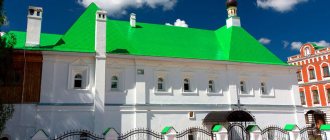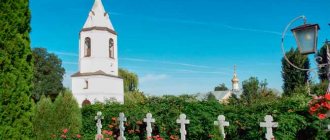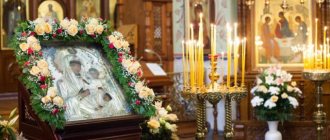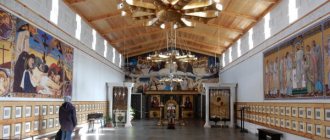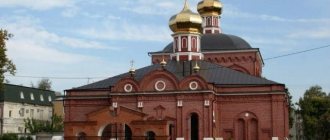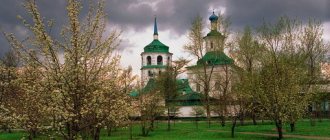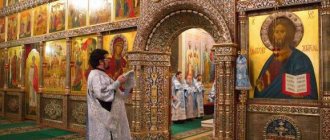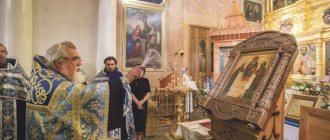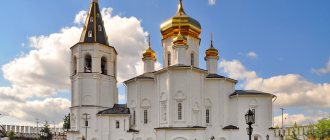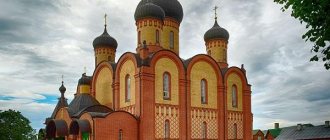Mir
Russia Pskov region Elizarovo village Spaso-Eleazarovsky Convent Map is loading…
{"format":"leaflet","minzoom":false,"maxzoom":false,"limit":50,"offset":0,"link":"all","sort":[""], "order":[],"headers":"show","mainlabel":"","intro":"","outro":"","searchlabel":"\u2026 \u0441\u043b\u0435\ u0434\u0443\u044e\u0449\u0438\u0435 \u0440\u0435\u0437\u0443\u043b\u044c\u0442\u0430\u0442\u044b","default":"","import-annotation":false,"width ":"auto","height":"350px","centre":{"text":"","title":"""link":"""lat":58.04991700000000065529093262739479541778564453125,"lon": 28.193822999999998302200765465386211872100830078125,"icon":""},"title":"","label":"","icon":"","lines":[],"polygons":[],"circles":[ ],"rectangles":[],"copycoords":false,"static":false,"zoom":8,"defzoom":14,"layers":["OpenStreetMap"],"image layers":[] ,"overlays":[],"resizable":false,"fullscreen":true,"scrollwheelzoom":true,"cluster":false,"clustermaxzoom":9,"clusterzoomonclick":true,"clustermaxradius":80, "clusterspiderfy":true,"geojson":"","clicktarget":"","showtitle":true,"hidenamespace":false,"template":"","userparam":"","activeicon": "","pagelabel":false,"ajaxcoordproperty":"","ajaxquery":"","locations":[{"text":"\u003Cb\u003E\u003Ca href=\"/palomnik/%D0% A1%D0%BF%D0%B0%D1%81%D0%BE-%D0%95%D0%BB%D0%B5%D0%B0%D0%B7%D0%B0%D1%80%D0%BE %D0%B2%D1%81%D0%BA%D0%B8%D0%B9_%D0%B6%D0%B5%D0%BD%D1%81%D0%BA%D0%B8%D0%B9_%D0 %BC%D0%BE%D0%BD%D0%B0%D1%81%D1%82%D1%8B%D1%80%D1%8C\" title=\"\u0421\u043f\u0430\u0441\u043e -\u0415\u043b\u0435\u0430\u0437\u0430\u0440\u043e\u0432\u0441\u043a\u0438\u0439 \u0436\u0435\u043d\u0441\u043a\u0438\u0439 \ u043c\u043e\u043d\u0430\ u0441\u0442\u044b\u0440\u044c\»\u003E\u0421\u043f\u0430\u0441\u043e-\u0415\u043b\u0435\u0430\u0437\u0430\u0440\u043e\u0432\u 0441\u043a\u0438\u0439 \u0436\u0435\u043d\u0441\u043a\u0438\u0439 \u043c\u043e\u043d\u0430\u0441\u0442\u044b\u0440\u044c\u003C/a\u003E\u003C/b\u00 3E","title": »\u0421\u043f\u0430\u0441\u043e-\u0415\u043b\u0435\u0430\u0437\u0430\u0440\u043e\u0432\u0441\u043a\u0438\u0439 \u0436\u0435 \u043d\u0441\u043a\u0438 "link":""lat":58.04991700000000065529093262739479541778564453125, "lon":28.193822999999998302200765465386211872100830078125,"icon":""}], "imageLayers":[]}
58.049917; 28.193823
Russia, Pskov district, Elizarovo village
Elizarovo village, Pskov region
Russia
Telephone:
8(8112) 679-558, mobile. 8-905-23-8888-2
Email:
Eleazarov in the name of Saints Basil the Great Gregory the Theologian and John Chrysostom; Spaso-Eleazar Monastery
- an Orthodox women's (formerly men's) monastery in the village of Elizarovo, Pskov district, Pskov region, Pskov diocese. Until 1906 it was called: Spaso-Eleazarov-Velikopustynsky-Trehsvyatitelsky male, 2nd class.
History[edit]
Foundation[edit]
25 kilometers north of Pskov, near the Gdov road and Pskov Lake stands the Spaso-Eleazarovsky Monastery, founded by St. Euphrosynus, Pskov Wonderworker. The Pskov Spaso-Eleazar Monastery is not the most famous monastic monastery, but in terms of its significance for Russia and for the destinies of mankind, it occupies a special place in world history.
It was here, in a deserted monastery located among forests, that the Constantinople Icon of the Mother of God, a gift from Patriarch Gennady II of Constantinople, was brought as a relay of succession. Here, a century later, Elder Philotheus formulated the idea of Russia’s universal responsibility for Orthodoxy, for humanity: “Two Romes have fallen, but a third stands, but a fourth will not exist.”
The place where the Spaso-Eleazar monastery is now located, blessed by God for monastic life. In ancient times, according to legend, the sisters of the Pskov Ioannovsky Monastery settled here, but the desert life turned out to be unbearable for the sisters.
Decades later, a monk from the Snetogorsk monastery Euphrosynus was called to this place. This happened in 1425.
The Monk Euphrosynus, in the world - Eleazar, originally from the Pskov village of Videlibye, received a good education. He entered the Snetogorsky monastery, where he took monastic vows with the name Euphrosynus. He was a scribe and theologian. To clarify issues related to the performance of worship, the Monk Euphrosynus went on foot to Constantinople and there was received by the Patriarch of Constantinople himself. Later, Patriarch Gennady II Scholarius donated the Constantinople Icon of the Mother of God for the blessing of the monastery. Four centuries before this event, when the division of the Church into Western and Eastern began, it was this image of the Most Holy Theotokos that was miraculously revealed in Constantinople. The brethren met the holy icon when they came out onto the road leading to Pskov. At this place, a holy spring called Prechistensky gushed out, and to this day it brings healing to people.
The Monk Euphrosynus would have liked to remain a desert dweller, but brethren flocked to him and asked him to found a monastery. The place was chosen in such a way that nothing would disturb the ascetic’s hermit’s life: between two branches of the river, under a hill, so there was nowhere to put the monastery buildings. Since it was here that three saints appeared to the Monk Euphrosynus in a subtle dream - Basil the Great, John Chrysostom and Gregory the Theologian, who ordered the creation of a cathedral in this place, the elder advised the brethren to dig a hill and cover one branch of the river with earth. In the resulting space, cells were built and a majestic cathedral was erected, which became a symbolic expression of the Universality of Orthodoxy.
The Monk Euphrosynus was a man of prayer, a true elder. Like St. Sergius of Radonezh, he became the teacher of many ascetics who, having left the Euphrosyne monastery, with the blessing of the elder, founded ten monasteries in the Pskov region and were glorified among the saints - Savva Krypetsky, Nikandr the Desert Dweller, Dositheus of Verkhneostrovsky, Hilarion of Pskovovozersky, Onufriy Malsky and other. Due to his humility, the Monk Euphrosynus, having founded the monastery, did not become its abbot and did not even receive priestly rank; the first abbot of Eleazar was Ignatius. In the akathist, which was composed in the Eleazar Monastery in the 19th century, it is sung: “Rejoice, glorious and humble Reverend Father Euphrosyne.”
Heyday[edit]
Neither before nor after St. Euphrosynus did the Pskov land know such a number of desert-dwelling companions and the monasteries they founded. And, by the way, the fates of the monasteries turned out to be very similar: foundation, service, destruction, revival, oblivion, and again - revival. None of the monasteries disappeared from the face of the earth. And the modern appearance of the Spaso-Eleazarovsky monastery is the brightest, most convincing evidence of the triumph of the Faith.
The Monk Euphrosynus died at the age of ninety-five, in 1481, having adopted the schema with the name Eleazar. In memory of him, the monastery has since been called Eleazarovskaya. His holy relics rested in the Trinity Cathedral. A will was placed on the shrine, personally written by the holy elder. It said: “I, God’s servant monk Euphrosynus, during my lifetime made a will about monastic life, about my patrimony, about fishing grounds and cages in the city and about everything that exists. I give all this at the disposal of my spiritual father, Abbot Harlampy, minister of the temple of the holy saints Basil the Great, Gregory the Theologian and John Chrysostom and the Monk Onuphrius, and all my brethren in Christ. And the abbot should not take advantage of this, and neither should the brethren, nor the cellarer, nor the settlers, nor the servants in the monastery. Use this property to support the brethren together.”
Together with the icon of the Most Holy Theotokos, the secret of the mystical Roman Empire, which is the image of the Kingdom of God on earth, was apparently revealed to the Monk Euphrosynus. But only a century later, when the Moscow state strengthened, the elder of the Spaso-Eleazarovsky monastery Philotheus announced to the whole world: “Moscow is the Third Rome,” and added: “Two Romes have fallen, and the third stands, and there will not be a fourth.” The Russian kingdom is the last world kingdom, after which will come the eternal kingdom of Christ.
Old Rome remained part of the holy Christian empire until the popes took on the dangerous mission of building an anti-church of the Latin heresy, which was based on the desire to dominate the whole world. Constantinople, the second Rome, remained the reigning city until it accepted the Union of Florence and desecrated Orthodoxy. By God's permission, Byzantium fell from the Turks. Responsibility for the fate of Orthodoxy fell on Moscow.
The ideal of Holy Rus' is not a manifestation of pride, but a messianic readiness to sacrificially serve God’s plan. Elder Philotheus warned the Moscow Prince Vasily Ivanovich: “You are the only Christian king in all of heaven. It is fitting for you, the king, to hold this with the fear of God. Fear God, who gave you this, do not rely on gold, wealth and glory, for all this is collected here and remains on earth here.”
“Orthodox Tsar” - by calling their Tsar this way, the Russian people thereby recognized his purpose as a guardian, a unifier, a liberator from Muslim barbarism and Western heresy.
The majestic theory of the historical vocation of Rus' was enshrined at the legislative level - in the decisions of the Stoglavy Council. More than a hundred years later, the words of Elder Philotheus were repeated almost verbatim in the Charter of the Moscow Consecrated Council of 1589, which approved the patriarchate in Rus' and was signed by the Patriarch of Constantinople Jeremiah.
The hermitage of St. Euphrosynus, lost among the age-old Pskov forests, was the spiritual center of the unification of Russian lands around Moscow. During the same period, the life of St. St. was compiled in the Eleazarov Monastery. Euphrosynus, the 2nd Pskov Chronicle was edited, and a copy of “The Tale of Igor’s Campaign”, which subsequently came to Musin-Pushkin, was rewritten.
While the Pskov-Pechersk monastery advocated the preservation of Pskov independence, the Eleazarovsky monastery united pundits who defended the need to strengthen the state around Moscow. The exponent of this idea was Abbot Philotheus (c. 1465-1542), the author of the “Moscow - Third Rome” theory. In his writings, he declared his strong support for the Grand Duke as “the holder of the bridge of God’s holy throne.”
In the Eleazarovsky monastery, this union of Moscow and Pskov is indicated in the architecture of the cathedral church: a chapel of the Nativity of the Blessed Virgin Mary in the Moscow style was added to the main, Trekhsvyatitelsky, cathedral of traditional Pskov architecture. The two churches, complementing each other, form a single cathedral complex. This has a deep meaning: Pskov is thought of as the beginning of Russian statehood, Moscow as its formation and greatness.
The main monastery shrine - the Cathedral of the Three Saints (Basily the Great, Gregory the Theologian, John Chrysostom) - was built around 1574 and is a magnificent example of medieval Pskov architecture.
The monastery was repeatedly attacked by Lithuanians, Poles and Livonian knights. In one such attack, the monastery was robbed and the miraculous icon of the Mother of God of Constantinople was stolen. According to monastery legend, the thieves, along with the shrine, died in Lake Psko, where it remains to this day. Soon a miraculous copy of the Constantinople Icon appeared in the monastery, which resides in the monastery.
Oblivion[edit]
Over time, the glory of the Spaso-Eleazar monastery began to diminish, and the sense of responsibility for the fate of mankind disappeared from the consciousness of the Russian people. Russia was no longer thought of as the Third Rome, and this theory itself was ridiculed and distorted by secular historians. But the Savior Himself took her under His protection. When the ecclesiastical states were published in 1764, it was left to its contents.
In 1766, the brethren of the abolished Velikopustinsky Transfiguration Monastery were transferred to it, which is why the monastery was also given the names Velikopustinskaya and Spasskaya. In the monastery church, a throne was consecrated in honor of the Transfiguration of the Lord, and the shrines of the Great Desert monastery were transferred here. At the same time, a miraculous icon was transferred to the monastery, which later received the name “Savior of Eleazar”.
In 1804, the brotherhood of the abolished Snetogorsk monastery was transferred to the Eleazar monastery.
In 1813, the monastery was elevated to the 2nd class, which it remained until the end of the Synodal period.
Since 1884, an almshouse operated at the monastery.
Until 1906 it was called: Spaso-Eleazarov-Velikopustynsky-Trehsvyatitelsky male, 2nd class; in 1906 it was transformed into a communal hermitage (Spaso-Eleazarova hermitage). This happened during the abbotship of Abbot Juvenal (Maslovsky).
His main activities were the improvement of church services, the introduction of eldership and the increase in brotherhood. In church services, he introduced splendor, order, decorum and the special desert singing of the Glinsk hermitage.
At the invitation of Fr. Juvenal in 1908, Schema-Archimandrite Gabriel, a student of the Optina elders, was transferred to retire to the Spaso-Eleazar hermitage. Among the elder’s spiritual children was the Grand Duchess Elisaveta Feodorovna, now glorified as a new martyr. She visited the monastery several times and took an active part in its organization and decoration.
In 1910, part of the brethren of the Glinsk Hermitage came here, famous for their eldership, communal life and special charter, which was laid, together with the charter of St. Euphrosynus, as the basis for the newly organized Eleazar Hermitage. At the same time, the converter’s attention was directed mainly to the internal renewal of the monastery, to the cultivation of true asceticism in the hearts of the brethren, in accordance with the monastic vows and covenants of its holy founders.
Thanks to the introduction of a hostel, the monastery was able to house up to a hundred residents within its walls instead of the previous two dozen. According to the monastery charter, each of the brethren had to be obedient, and all work, even the most menial, in the monastery was carried out by the monks themselves. For economic needs, the monastery established tailoring, shoemaking, and carpentry workshops; it had its own painters, plasterers, etc. An icon painting workshop was set up. The monastery could satisfy all economic needs with its own resources and resources.
Every year, on the feast of the apostles Peter and Paul, June 29 and 30 according to Art. style (12 and 13 AD), with the icon of the Savior, a religious procession was made from the monastery along the waters of Lake Pskov to the island of Talabsk, and then to the island of Verny to the monastery of Peter and Paul. The tradition of holding a religious procession continued until the 50s of the 20th century.
By 1917, there were 18 monastics and 15 novices in the Spaso-Eleazar Monastery; land holdings amounted to 338 acres.
In 1918, the Royal Family died, a retreat from the faith occurred, and in the same year the Spaso-Eleazarovsky monastery was closed, the monks were taken on carts towards Petrograd and there they accepted martyrdom. With the fall of the Empire of the Third Rome, the place from which the prophecy about the sacred mission of Russia was made was destroyed, the monastery was closed and ruined.
Back in the spring of 1920, there was a monastery church, from where church utensils were taken out three times “to help the starving people of the Volga region.” In the summer of the same year, an institute was first opened on the territory of the monastery, from which professors and students almost immediately moved to Petrograd. Then the authorities tried to organize exemplary agricultural production; It took several months for what the monks had created to crumble. Alternately, the People's House, a home for defective children, a children's tuberculosis sanatorium and a recreation center were opened in the Eleazarovsky monastery. Until 1999, the children’s sports camp “Shield” and a residential complex were located on the territory of the monastery. Of more than twenty buildings, only the cathedral church and a two-story fraternal building remained.
Current state[edit]
On May 28, 2000, on the day of memory of St. Euphrosynus, a bishop's service was held in the monastery. This day is considered the date of the revival of the ancient Spaso-Eleazar monastery.
On August 25, 2000, with the blessing of the ever-memorable His Holiness Patriarch of Moscow and All Rus' Alexy II, nun Elizabeth was appointed abbess of the Spaso-Eleazarovsky Convent.
In 2005, nun Elizabeth was elevated to the rank of abbess, and 8 nuns were tonsured. In 2005, the restoration of the 1904 fraternal building was completed. On August 10, 2005, Bishop Eusebius served the rite of blessing the bells at the restored belfry.
On the island of Zalita (Talabsk), which is located in Lake Pskov opposite the Spaso-Eleazarovsky Monastery, Father Nikolai Guryanov lived for four decades. He prayed for the restoration of the monastery; he was the custodian of the Constantinople Icon of the Mother of God, which had previously been in the monastery of St. Euphrosynus. The path along which the priest walked with trepidation and reverence is called the road of the Savior; along it they brought the miraculous icon of the Savior from the monastery to the island.
What can you see in the monastery these days?
Today the monastery has been beautifully restored. The main thing in it is the majestic Trinity Cathedral.
The first stone temple appeared on this site in 1447, and then was rebuilt many times. Today it is a three-apse, single-domed church with a small bell tower above the stairs. It has 7 bells cast by Voronezh craftsmen.
Chapel of the Savior of the Image Not Made by Hands of the Spaso-Eleazarovsky Monastery
In the snow-white abbot's house there is a small temple of the Archangel Gabriel. Near the road there is a recently built beautiful chapel of the Savior of the Image Not Made by Hands. And in the building occupied by the pilgrimage center, its own house temple was created. In addition, on the monastery territory surrounded by a fence, there are two sister buildings and outbuildings.
How to get there[edit]
Address:
180523, Pskov region, Pskov district, p.o. Elizarovo
Directions:
The Spaso-Eleazarovsky Monastery is located 30 km north of Pskov. The most convenient way to get to Pskov from Moscow is by train from Leningradsky Station. From Pskov, from the bus station, buses go to Gdov - on the road they pass the village of Elizarovo, where the Elizarovskaya monastery is located.
If you are traveling by car, then from Pskov you should leave along Leon Pozemsky Street (this is one of the main thoroughfares of the city) - outside the city limits it turns into the P-60 highway leading to Gdov. In the village of Elizarovo, the road goes straight along the monastery fence (the fence stretches on the left hand).
Telephone:
8(8112) 679-558, mobile. 8-905-23-8888-2
Email:
Website:
https://eleazarovo.ru/
Page on the social network “Vkontakte”:
https://vk.com/club182122708
Monastery visiting mode
Today the Spaso-Eleazarovsky Monastery is a functioning Orthodox women's monastery. Church services are held daily in the monastery churches. A monastic community lives here, led by the abbess. The monastery is open to visitors from morning to evening, however, tourists are not allowed access to some buildings. In addition, all guests are asked not to take photographs of nuns and novices.
Chapel at the burial site of the first abbess, Hegumenia Elizabeth
